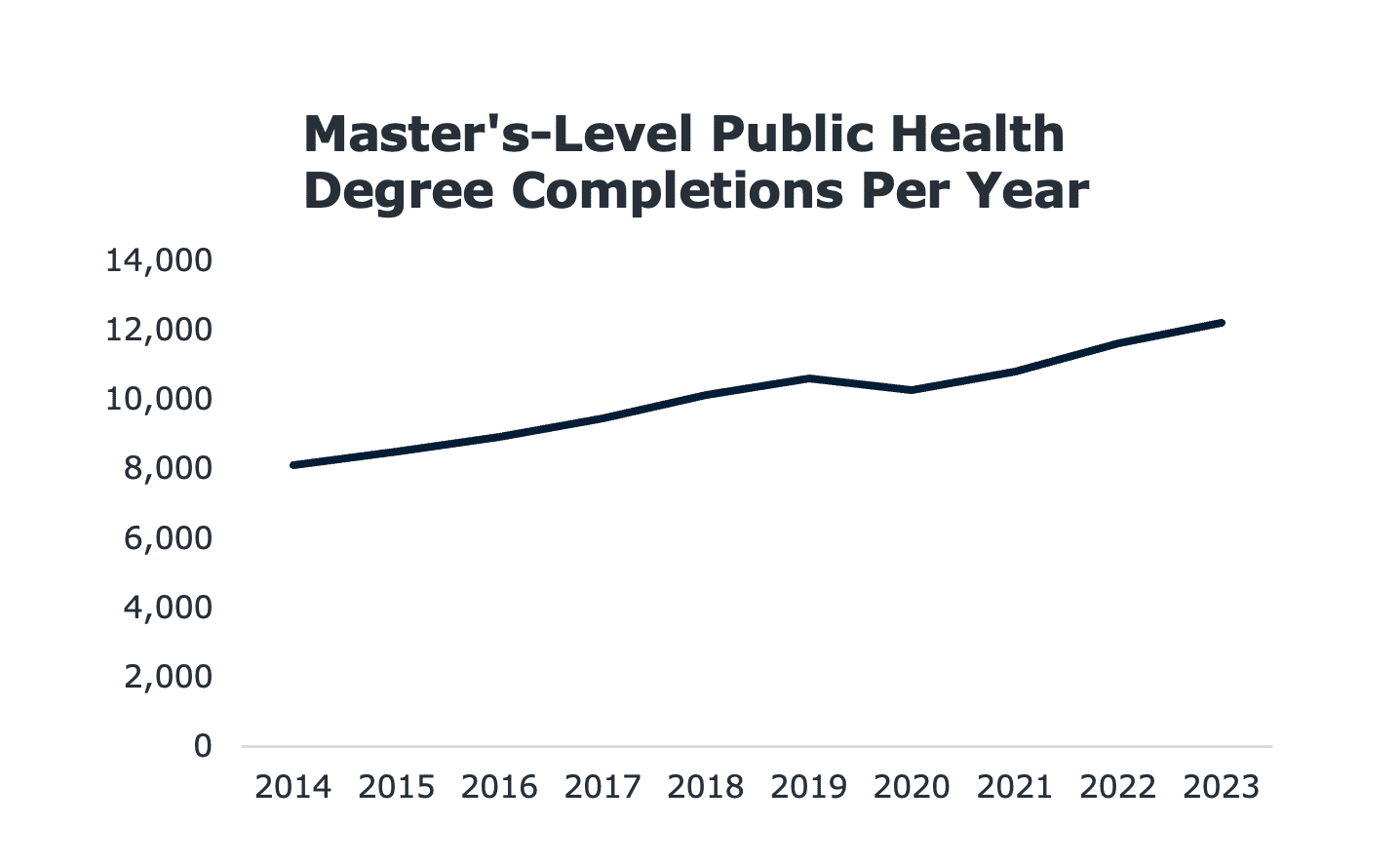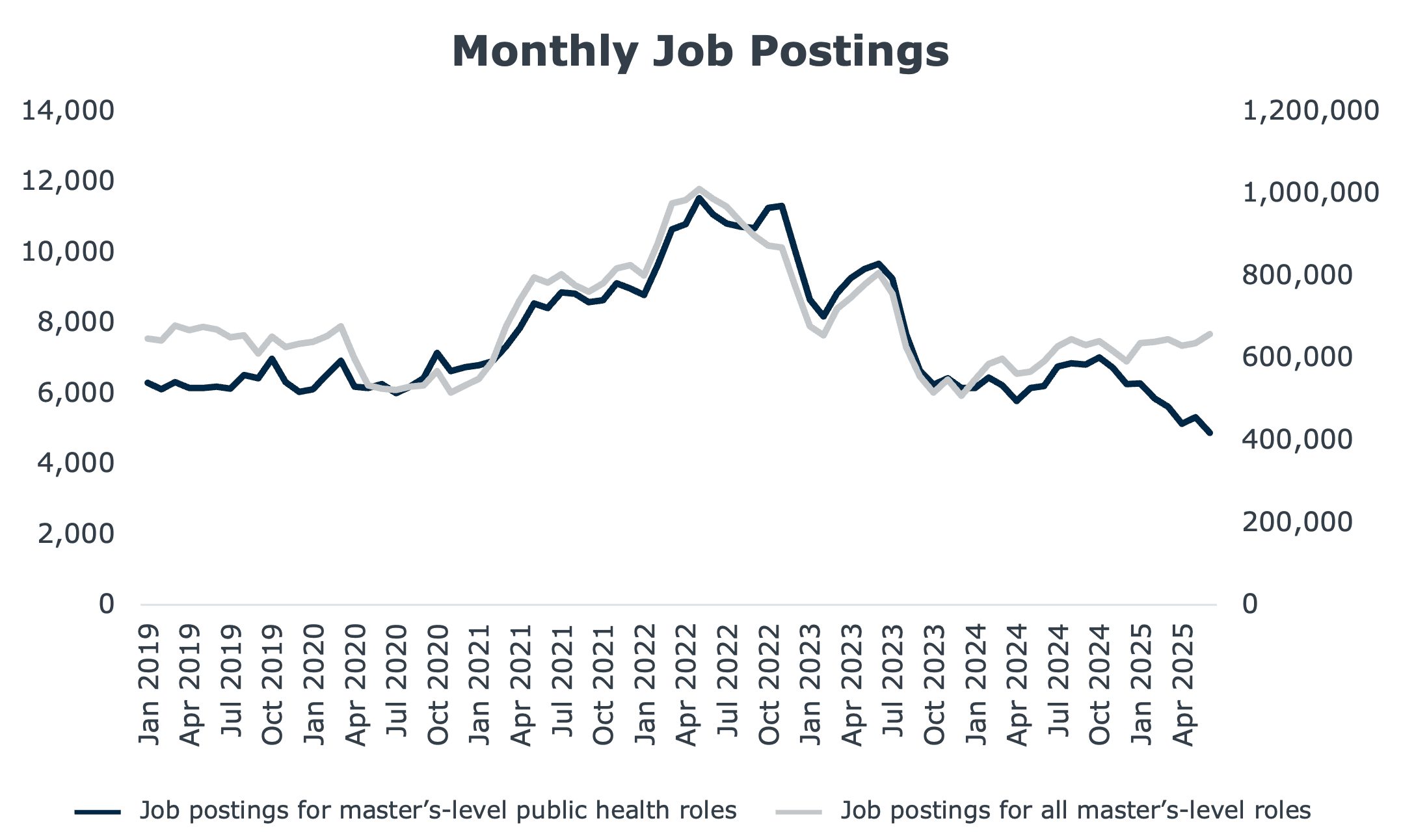The future of master’s-level public health programs
The COVID-19 pandemic brought a surge of attention to the public health field, with searches including the term “public health” increasing by more than 300% in spring 2020. And while the pandemic is no longer a global emergency, public health professionals continue to provide an essential service. Public health professionals prevent, track, and treat diseases, address health disparities, and provide preventative health care to ensure the health and wellness of all people.
But recent political actions have shut down or reduced funding to many public health programs. Within this shifting market, it’s essential to understand how demand for public health professionals has changed and how Master of Public Health (MPH) programs must adapt to maintain student interest and prepare graduates for employment. Read on for our latest research on the state of the public health market—and how universities can respond to these emerging trends.
1. Student demand for Master of Public Health programs remains strong
Demand for MPH programs as measured by degree completions is at an all-time high, with 12,220 completions reported in the 2022-2023 academic year. Aside from a slight decline in 2020, likely due to the start of the COVID-19 pandemic preventing that semester’s completions, conferrals for master’s-level public health programs have increased every year for the past decade.

A slightly more challenging landscape emerges when we examine student demand based on MPH program applications. According to a 2024 study encompassing 123 public health schools nationwide, applications to MPH programs peaked in the 2020-2021 academic year and have declined since (of note, over 300 schools report MPH graduates, so this data reflects less than half of the market), Ultimately, applications in the 2022-2023 academic year still exceeded application levels between 2015 and 2019, signaling strong student interest in MPH programs.
The Demographic Trends Impacting the Future of Master’s Enrollment
2. Employer demand for public health professionals aligned with national labor market trends—until November 2024
While the COVID-19 pandemic increased attention on the public health field, this attention largely did not translate into additional jobs. Since 2019, employer demand for public health professionals has mostly aligned with demand for all professionals with a master’s degree. National job postings across fields have fluctuated since 2019, peaking in early to mid-2022 and early 2023 before stabilizing in early 2024. The public health labor market fared slightly better than average in 2020, late 2022, and early 2023, but nonetheless mostly aligned with demand trends for all master’s-level professionals.
However, demand for public health professionals began declining in November 2024 while the master’s-level labor market remained steady, likely due to anticipated and later implemented federal policy changes affecting public health jobs.

3. Recent political changes have challenged the public health labor market
Over the past year, the Trump Administration has made significant cuts to federally funded public health programs and initiatives. The federal government cancelled $6.8 billion in health research grants and has proposed steep cuts to scientific research grants and health care programs, including Medicaid and the Indian Health Service. The Trump Administration has eliminated or proposed eliminating several public health programs, such as injury prevention and infectious disease tracking programs. Internationally, the United States has withdrawn from the World Health Organization, shut down USAID, and frozen funding for several international public health programs.
These cuts are likely responsible for the significant decline in master’s-level public health job opportunities since November 2024. There were 4,882 relevant job postings for master’s-level public health professionals in June 2025, compared to 6,199 in June 2024, or a net decline of 1,317 job postings over the course of one year. This decline occurred across industries spanning public health.
Explore Labor Market Demand Trends in Your State
But some industries were more affected than others, with higher ed, direct health and medical insurance carriers, and other general government support employers experiencing the most significant net declines. Colleges in particular have been deeply impacted by reductions in research funding, suggesting fewer future opportunities in academia or scientific research for public health graduates.
How can colleges and universities respond?
To ensure student interest in your program remains strong amid a rapidly changing labor market, it’s critical to prepare students with widely applicable skills. Before and after the pandemic, some skills remain essential to Master of Public Health degrees. Students will always need to understand the basic disciplines within public health, such as community health or biostatistics. Other skills remain useful regardless of whether students enter the public health field upon graduation, such as project management or data analysis.
But COVID-19 shifted the public health landscape. The pandemic accentuated health disparities, reinforcing the need for students who understand health equity and human services. Additionally, as people come to realize the importance of preventative health programs, public health graduates will need to understand how to interact directly with the medical system and medical records.
Top skills public health graduates need
Fundamental Skills
| Skill | Average Monthly Proportion of Job Postings Requesting This Skill |
|---|---|
| Public Health | 51.41% |
| Epidemiology | 25.39% |
| Social Work | 22.01% |
| Data Analytics | 18.23% |
| Project Management | 16.43% |
| Statistics | 13.48% |
| Community Health | 16.16% |
| Health Education | 12.94% |
| Biostatistics | 11.24% |
| Data Collection | 11.66% |
Emerging Skills
| Skill | Net Increase in Average Monthly Proportion of Job Postings Requesting This Skill from Q1 2019 to Q2 2025 |
|---|---|
| Health Equity | 5.45% |
| Ethical Standards and Conduct | 4.97% |
| Medical Records | 4.42% |
| Health Sciences | 3.85% |
| Behavioral Health | 3.83% |
| Electronic Medical Record | 3.77% |
| Human Services | 3.77% |
| Biology | 3.75% |
| Data Analysis | 3.49% |
| Community Health | 3.47% |
When we examine most in-demand skills, two key areas emerge:
- Public health graduates must be able to work directly with communities in need. They’ll need to understand how to educate people, convince them to adopt healthy behaviors, and connect them with government and public health services.
- At the same time, public health graduates will be required to learn the logistical skills needed to manage large-scale public health projects. Skills such as data analysis, statistics, and epidemiology are essential to understanding the need for health care services in communities. Project management skills are also necessary to ensure that public health programs run smoothly. Additionally, these skills are highly transferable, making them attractive to career-minded students even in a turbulent labor market for public health.
| Community Interaction | Data Analysis and Management |
|---|---|
| Behavioral Health | Biostatistics |
| Community Health | Data Analysis |
| Ethical Standards and Conduct | Data Collection |
| Health Education | Electronic Medical Record |
| Health Equity | Epidemiology |
| Human Services | Medical Records |
| Social Work | Project Management |
| Statistics |
In today’s tumultuous labor market and political landscape, it’s more important than ever to develop a program that will prepare students for today’s changing market. By providing essential skills, highlighting your program’s unique value proposition, and demonstrating the return on investment available to students, your program will be better positioned to capture record-high student demand. Develop coursework and experiential learning opportunities that equip students with skills in community engagement, project management, and data collection and analysis.
If you’re interested in more specific data on demand for public health programs within your region to help inform program design, request a report from EAB’s Market Insights team.

More Blogs

Adult learners: who they are and what they want from college

4 questions domestic students will ask before applying to your graduate program
